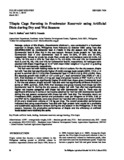Tilapia cage farming in freshwater reservoir using artificial diets during dry and wet seasons
- Global styles
- MLA
- Vancouver
- Elsevier - Harvard
- APA
- Help
Share
นามธรรม
Netcage culture of Nile tilapia, Oreochromis niloticus L., was conducted in a freshwater reservoir in Dingle, Iloilo, Philippines from February to October 2009 using Test diet (SEAFDEC/AQD) vs. Commercial feed A (Tateh) in the dry season and Test diet vs. Commercial feed B (Hoc Po) in the wet season. Percent crude protein for Test diet, Commercial feed A and Commercial feed B were 34–35%, 27–33% and 25–32%, respectively. Values for crude fat, crude fiber, crude ash and moisture were 6.0–6.5%, 3.5–5.0%, 10–12% and 4–12% for Test diet; 5–7%, 4.0–8.0%, 12% and 12% for Commercial feed A; and 7%, 4%, 12% and 12% for Commercial feed B, respectively. All netcages were stocked with tilapia fingerlings at 15 m-3 with mean initial weight of 1.2 g and 1.3 g during the dry and wet seasons, respectively.
The fish were fed with floating feeds for 87–89 d of culture. For the dry season, tilapia fed with Test diet had significantly higher (P<0.05) average body weight (ABW, 173.0 ± 1.3 g) and % survival (95.3 ± 2.2%) than Commercial feed A (158.0 ± 0.5 g, 92.0 ± 0.6%). Also, the absolute growth rate (AGR) of 1.97 ± 0.02 g d-1, feed conversion rate (FCR) of 1.29 ± 0.01, final biomass of 154.60 ± 2.4 kg per cage and gross income of PhP 13,914 ± 18 for Test diet-fed tilapia were significantly higher (P<0.05) than those given Commercial feed A. For the wet season, tilapia fed with Test diet were not significantly different (P>0.05) in terms of ABW, survival, AGR, FCR, final biomass and gross income from those fed with Commercial feed B. During the dry season, tilapia fed with Test diet had significantly higher net income compared with those fed with Commercial feed A. There was no significant difference in terms of net income obtained for fish fed with Commercial feed B during the wet season compared with those fed with Test diet. The favorable return on investment (ROI), payback period and production cost per kilogram at 67.83%, 0.62 yr and PhP 46.72, respectively, were also shown by Test diet with a break-even price of PhP 67.55 and a break-even volume of 116 kg per crop. The overall production performance indicated that using cost-effective Test diet with high protein level would be a profitable and sustainable aquaculture venture during the dry season in the Philippines. In the wet season, however, the productive performance of tilapia and the efficiency of artificial feeds tested were relatively the same.
การอ้างอิง
Baliao, D. D., & Dosado, N. S. (2011). Tilapia cage farming in freshwater reservoir using artificial diets during dry and wet seasons. The Philippine Agricultural Scientist , 94(1), 38-45. http://hdl.handle.net/10862/992
Type
ArticleISSN
0031-7454คอลเลกชัน
- Journal Articles [1258]


